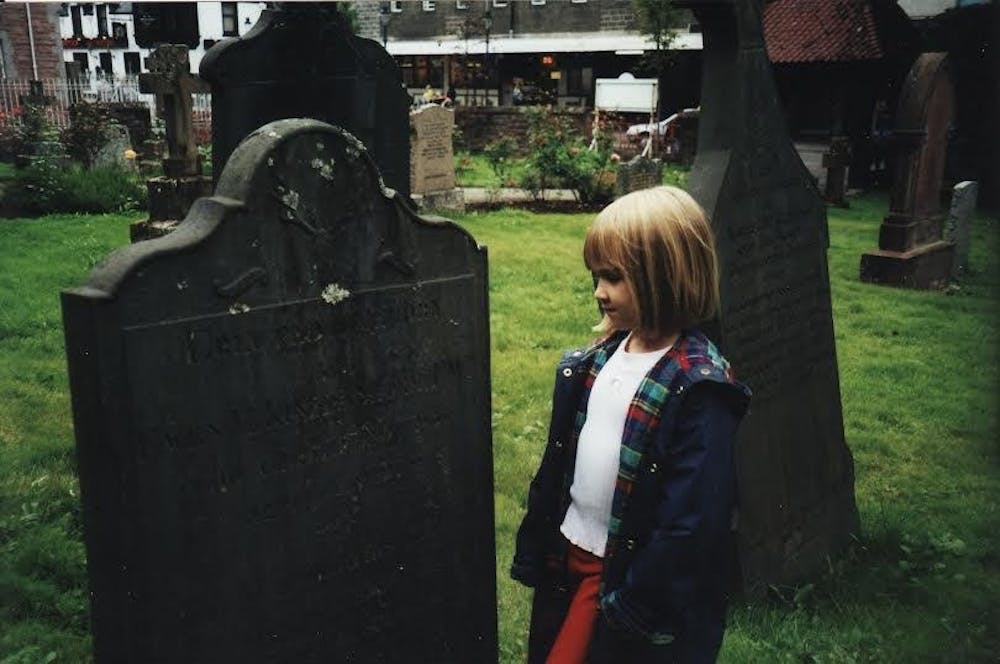“I didn’t learn how to ride a bike until I was 16” has always been my go-to fun fact at parties. With respect to my dignity, I never found the fact all that “fun;” I was merely unable to think of a weird quirk which would elicit equally entertaining reactions from my fellow breakers-of-the-ice. That is, until now.
On a recent phone call home, my dad reminded me of my inexplicable childhood infatuation with graveyards. It was an unsettling trait that became noticeable around the age of four — at the beginning of my family’s two-year stint in the UK.
Insufferable explorers, my parents frequently drove my infant brother and I through the rolling hills of the ever-gloomy English and Scottish countrysides. When we passed a cathedral or ruinous cemetery, I would press my nose to the cold glass in the backseat and invariably implore, “Mum, could we please, please have a look.” The accent, though fleeting, was admittedly pretty cute.
My parents marveled — or, more accurately, apprehensively observed — as my little blonde head bobbed between rows of weathered gravestones as I carefully scrutinized epitaphs of the centuries deceased. Though I’m still unsure what I found so captivating — ghosts, dead people, the general morbid ambience — I do know the casting director of “The Sixth Sense” really missed out on a gem with me.
I’m beginning to suspect part of this bizarre childhood fascination never fully dissipated since I’ve spent more of my summer than I care to admit perusing the cemetery off McCormick Road. One evening, I ran to the Gooch-Dillard dorms to investigate the gravesite believed to belong to enslaved laborers of the Maury Family. And on an 11-p.m. excursion another night, I wandered into the unlocked, dimly lit University Chapel — not something I’d recommend if you’re easily spooked or superstitious.
Part of the University’s mystique is rooted in its rich — and sometimes sinister — antebellum history. However, this arcane past is easily overlooked if you are not paying attention.
In my probationary training for the University Guide Service, I read about the unmarked gravesites of some 67 people — again, likely enslaved laborers — directly behind the McCormick Cemetery. Despite its magnitude and importance, this burial site wasn’t even discovered until 2012, and the vast majority of people are completely unaware of its existence on Grounds.
Similarly, I think it’s a shame how some students will pass through this University with virtually no conception of its role in the Civil War, without ever reading “The Honor Men” in its entirety or without stepping foot in the Special Collections Library — or knowing where it is located. I’ve spent an inordinate amount of my summer poring over Special Collections archives and historical records pertaining to Edgar Allan Poe, the 1895 Rotunda fire and early slavery at the University.
Admittedly, this is not everyone’s ideal way to pass free time, and I don’t blame students for ignorance of or apathy toward these subjects. My first-year self paid no mind to the historical relevance of this place until a film photography class forced me to pay attention to details and inscriptions. However, I think it would do many people good to meander around Grounds for a couple of hours. You never know what you might dredge up or what might pique your interest.
To be fair, I recognize that my keen interest in the ghosts of this University might be oddly unique. This past semester, I purchased a first-edition booklet entitled “Story of an ‘Academical Village’” on a whim from an old antique shop in remote Ohio. The beloved Rotunda Hostess, Mary Hall Betts, wrote the dilapidated book in 1961. I’ve also dedicated a photography project to documenting some of the obscure and beautiful components that make up this University, including Rugby Road, the “Students Progress” mural in Old Cabell Hall and the stone mosaic in Poe’s Alley. Ultimately, I recognize not everyone wants to go to these somewhat bizarre lengths to examine the University.
However, whether it’s the University’s history or horticulture or 1950s jazz bands or black holes or French cuisine or anthropomorphic taxidermy, I hope you find something you’re curious about. I hope you relentlessly pursue it. I hope you examine it closely and share your findings for others to revel in.
If you haven’t already, I hope you find your cemetery — in the metaphorical sense.
Tori’s column runs biweekly. She can be reached at t.travers@cavalierdaily.com.





